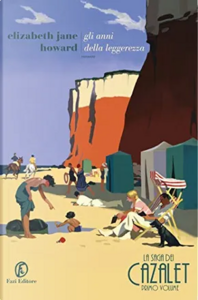You need to sign in or sign up before continuing.
Take a photo of a barcode or cover
Ce roman aurait pu s'intituler "tranches de vie des Cazalet"...
On suit donc, le temps d'un été, la vie de cette famille composée du patriarche et de son épouse, et de leurs trois fils aux caractères très différents, entourés de leurs familles. La part belle est donnée à la campagne anglaise dans cet ouvrage, et à la vie entre deux guerres dans une famille britannique aisée. On assiste également à la montée en puissance des hostilités entre l'Allemagne et le reste de l'Europe à la fin des années 30.
Je suis en fait mitigée sur cette lecture : durant tout le roman, je me suis dit "il ne se passe rien..." mais j'ai été surprise d'arriver si vite à la fin. Et j'ai beaucoup aimé avoir également le point de vue des enfants dans cette histoire...
On suit donc, le temps d'un été, la vie de cette famille composée du patriarche et de son épouse, et de leurs trois fils aux caractères très différents, entourés de leurs familles. La part belle est donnée à la campagne anglaise dans cet ouvrage, et à la vie entre deux guerres dans une famille britannique aisée. On assiste également à la montée en puissance des hostilités entre l'Allemagne et le reste de l'Europe à la fin des années 30.
Je suis en fait mitigée sur cette lecture : durant tout le roman, je me suis dit "il ne se passe rien..." mais j'ai été surprise d'arriver si vite à la fin. Et j'ai beaucoup aimé avoir également le point de vue des enfants dans cette histoire...
I have to admit my total ignorance about Elizabeth Jane Howard. The Cazalet saga had a great success in Italy in the last few years, but before getting to start it (I vaguely knew something of the plot and it seemed to be something I'd enjoy), I was convinced the author was a modern author, still alive, and this was her debut novel. I was so very wrong!
I think the author amongst the few made me like a book with a lot of characters, a thing that I normally despise, and makes me put the book down. The Cazalet family is depicted in every one of its components, even the smallest ones. Each and every one of them unravels slowly on the plot, forming in the reader an overview of the whole lot and making them pick their favourite - or least favourite.
The first two summers narrated here - 1938 and 1939 - bring different vibes. Partially because the youngest characters start to transform and show a glimpse of the future chapters, partially because the second summer is haunted by the threat of war and how this would change everything.
It is incredibly modern in the topics that are brought into the plot: the role of women, the expectations of being born in a middle-class family, the expectations of marriage, homosexuality, antisemitism, rape, harassment, and abortion.
This is even more incredible if you think that the author has lived those same years, but she seems to see the events with a way more modern view.
The middle part of the book is probably a bit slow, especially as it introduces more characters, but it makes way more sense towards the end and again is projecting what could happen in the future.
I think the author amongst the few made me like a book with a lot of characters, a thing that I normally despise, and makes me put the book down. The Cazalet family is depicted in every one of its components, even the smallest ones. Each and every one of them unravels slowly on the plot, forming in the reader an overview of the whole lot and making them pick their favourite - or least favourite.
The first two summers narrated here - 1938 and 1939 - bring different vibes. Partially because the youngest characters start to transform and show a glimpse of the future chapters, partially because the second summer is haunted by the threat of war and how this would change everything.
It is incredibly modern in the topics that are brought into the plot: the role of women, the expectations of being born in a middle-class family, the expectations of marriage, homosexuality, antisemitism, rape, harassment, and abortion.
This is even more incredible if you think that the author has lived those same years, but she seems to see the events with a way more modern view.
The middle part of the book is probably a bit slow, especially as it introduces more characters, but it makes way more sense towards the end and again is projecting what could happen in the future.
Spoiler
I found the final paragraphs a true masterpiece of literature, where all the characters have reasons to sigh in relief when the war is averted, but alongside a bit disappointed for how their life could have been otherwise.
challenging
emotional
funny
hopeful
inspiring
lighthearted
slow-paced
Villy, Zoë e Polly personaggi preferiti. Subito seguite da Louise, Rachel e Hugh.
Amo come ogni personalità e relazione sia stata delineata in maniera così chiara e caratteristica da restare impressa senza sforzo.
Si respira tutta l'atmosfera di quel tempo e non vedo l'ora di proseguire la lettura dei prossimi.
Amo come ogni personalità e relazione sia stata delineata in maniera così chiara e caratteristica da restare impressa senza sforzo.
Si respira tutta l'atmosfera di quel tempo e non vedo l'ora di proseguire la lettura dei prossimi.
I usually don't like when the POVs switch so often in a book, but in this one it wasn't annoying at all, and that, for me, shows how good of a writer mrs. Howard was.
The fact that she was a teen in the years described in this book really shows, you can tell by the way she perfectly describes the life at the time - the small details of the every day life, that is.
One of the things that struck me the most were the children: they are characters, with their own thoughts and their actions are always extremely believable.
It was of course a bit difficult at first to remember every single name (like sometimes I confused the names of the children and I had to check on the first page with the family tree haha), but after a while it is like reading about some close friends, and it's hard to put down the book - I suppose also thanks to the frequent POV switch.
The fact that she was a teen in the years described in this book really shows, you can tell by the way she perfectly describes the life at the time - the small details of the every day life, that is.
One of the things that struck me the most were the children: they are characters, with their own thoughts and their actions are always extremely believable.
It was of course a bit difficult at first to remember every single name (like sometimes I confused the names of the children and I had to check on the first page with the family tree haha), but after a while it is like reading about some close friends, and it's hard to put down the book - I suppose also thanks to the frequent POV switch.
siin raamatus on üks tegelane, kes praktilistel põhjustel (taskuraha vähesus) ostab raamatuid selle järgi, et oleks võimalikult paks ja annaks kaua lugeda, isegi kui eriti huvitav ei ole. mul tekkis ka mingi hetk tunne, et tegu ongi teosega inimesele, kellel ühtegi teist raamatut lugeda ei ole - seda on lihtsalt nii tohutult palju ja suurem osa ajast midagi nagu ei juhtu, lihtsalt... maht.
ei, tegelt ei ole nii hull, igav ka ei ole. see on lihtsalt selline eeposemõõtu heietus, kus ei ole üht kangelast, vaid terve suguvõsa kõik liikmed saavad kordamööda sõna. vanaema-vanaisa, kõik pojad ja miniad armukesed ja vallaline tütar ja tema sõbranna ja majateenijad ja guvernant ja miljon eri vanuses last ja isegi lemmikloomade matustele pühendatakse päris palju leheküljeruumi. eks selles pisikeses plaanis ikka juhtub asju, igaühe elus on mingit mõõtu draamad, seejuures kohe näha, et väiksematel lastel väiksemad ja suurematel suuremad mured. kõik need inimesed sobivalt suvitavad koos ühes järjest laienevas majapidamises, kus rahapuudust otseselt ei ole ja valitseb üldse selline briti kõrgema keskklassi hubasus.
ja päris suures plaanis juhtub ka asju, sest tegevus toimub suvedel 1937 ja 1938 ja kui raamatu esimese poole lõpuks ma veel eriti ei saanud aru, miks ma seda loen (ja selleks ajaks olin lugenud juba 236 lk), siis teine pool, 1938, keris juba päris meisterlikult sõjahirmu üles. mind tabas mingi laiemas plaanis uus mõistmine küll siinkohal, sest see Chamberlaini "peace for our time" jutt on minu ajastust ja maailmanurgast vaadates alati nii... hale ja vale tundunud. aga kui olin elanud üle 500 lehekülje selle aja briti naiste, laste ja vanainimeste peades (põhiliselt. mehed olid ikka ka ja need mehed olid üldiselt ühe maailmasõja juba läbi teinud), siis muutus see vaatenurk kuidagi arusaadavamaks.
nii et lõpuks ikkagi pean tunnistama, et oli päris hea raamat, ei saa isegi öelda, et liiga pikk, sest see pikkus teenis selgelt oma eesmärki. ja ei olnud igav. ja oli hästi kirjutatud. aga ma olin suurema osa lugemise ajast kindel, et järgmisi osi (neid on 4 veel!) ma küll ei loe. praegu on natuke tunne, et tahaks ikkagi teada, kuidas neil see sõjaaeg läks (ses mõttes, et sorry, kui see kellegi jaoks sisurikkujaks osutub, aga Chamberlainil ei olnud õigus ja see kõik ei lõppenud igavese rahuga), aga... kui ma mõtlen, kui palju teisi lugusid ma saaks läbi lugeda selle asemel, et end Cazalet' perekonna iga viimase kui liikme iga viimase kui mõttega kurssi viia... ei, ma ei usu, et ma hakkan.
ei, tegelt ei ole nii hull, igav ka ei ole. see on lihtsalt selline eeposemõõtu heietus, kus ei ole üht kangelast, vaid terve suguvõsa kõik liikmed saavad kordamööda sõna. vanaema-vanaisa, kõik pojad ja miniad armukesed ja vallaline tütar ja tema sõbranna ja majateenijad ja guvernant ja miljon eri vanuses last ja isegi lemmikloomade matustele pühendatakse päris palju leheküljeruumi. eks selles pisikeses plaanis ikka juhtub asju, igaühe elus on mingit mõõtu draamad, seejuures kohe näha, et väiksematel lastel väiksemad ja suurematel suuremad mured. kõik need inimesed sobivalt suvitavad koos ühes järjest laienevas majapidamises, kus rahapuudust otseselt ei ole ja valitseb üldse selline briti kõrgema keskklassi hubasus.
ja päris suures plaanis juhtub ka asju, sest tegevus toimub suvedel 1937 ja 1938 ja kui raamatu esimese poole lõpuks ma veel eriti ei saanud aru, miks ma seda loen (ja selleks ajaks olin lugenud juba 236 lk), siis teine pool, 1938, keris juba päris meisterlikult sõjahirmu üles. mind tabas mingi laiemas plaanis uus mõistmine küll siinkohal, sest see Chamberlaini "peace for our time" jutt on minu ajastust ja maailmanurgast vaadates alati nii... hale ja vale tundunud. aga kui olin elanud üle 500 lehekülje selle aja briti naiste, laste ja vanainimeste peades (põhiliselt. mehed olid ikka ka ja need mehed olid üldiselt ühe maailmasõja juba läbi teinud), siis muutus see vaatenurk kuidagi arusaadavamaks.
nii et lõpuks ikkagi pean tunnistama, et oli päris hea raamat, ei saa isegi öelda, et liiga pikk, sest see pikkus teenis selgelt oma eesmärki. ja ei olnud igav. ja oli hästi kirjutatud. aga ma olin suurema osa lugemise ajast kindel, et järgmisi osi (neid on 4 veel!) ma küll ei loe. praegu on natuke tunne, et tahaks ikkagi teada, kuidas neil see sõjaaeg läks (ses mõttes, et sorry, kui see kellegi jaoks sisurikkujaks osutub, aga Chamberlainil ei olnud õigus ja see kõik ei lõppenud igavese rahuga), aga... kui ma mõtlen, kui palju teisi lugusid ma saaks läbi lugeda selle asemel, et end Cazalet' perekonna iga viimase kui liikme iga viimase kui mõttega kurssi viia... ei, ma ei usu, et ma hakkan.
emotional
funny
relaxing
slow-paced
Plot or Character Driven:
A mix
Strong character development:
Complicated
Loveable characters:
Complicated
Diverse cast of characters:
Yes
Flaws of characters a main focus:
N/A








